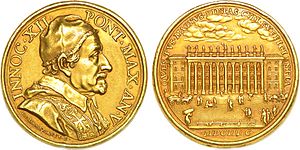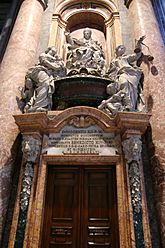Pope Innocent XII facts for kids
Quick facts for kids Pope Innocent XII |
|
|---|---|
| Bishop of Rome | |

Portrait by Antonio Zanchi, c. 1691 – 99
|
|
| Church | Catholic Church |
| Papacy began | 12 July 1691 |
| Papacy ended | 27 September 1700 |
| Predecessor | Alexander VIII |
| Successor | Clement XI |
| Orders | |
| Ordination | c. 1643 |
| Consecration | 27 October 1652 by Marcantonio Franciotti |
| Created Cardinal | 1 September 1681 |
| Personal details | |
| Birth name | Antonio Pignatelli |
| Born | 13 March 1615 Spinazzola, Kingdom of Naples |
| Died | 27 September 1700 (aged 85) Rome, Papal States |
| Previous post |
|
| Coat of arms |  |
| Other Popes named Innocent | |
Pope Innocent XII, born Antonio Pignatelli, was the leader of the Catholic Church from 1691 until his death in 1700. He was also the ruler of the Papal States, which were lands controlled by the Pope.
He was known for being very strict against nepotism. This is when people in power give special jobs or favors to their family members. Pope Innocent XII wanted to stop this practice in the Church. He followed the ideas of an earlier pope, Pope Innocent XI, who also tried to fight nepotism. To make sure his rules were followed, he wrote an important Church law that strictly banned giving Church money or land to relatives.
Contents
About Pope Innocent XII
Early Life and Education
Antonio Pignatelli was born on March 13, 1615, in a town called Spinazzola. This area is now part of Italy. His family was very important and wealthy in the Kingdom of Naples. Many of his relatives had been important leaders and government officials.
Antonio was one of five children. He went to school at the Collegio Romano in Rome. There, he studied and earned a special degree in both Church law and civil law.
Early Career and Church Roles
When he was 20, Antonio Pignatelli started working for the Pope's court. He held different jobs, like being a governor in Italian cities such as Fano and Viterbo.
Later, he worked as an inquisitor in Malta from 1646 to 1649. After that, he became the governor of Perugia. Soon after these roles, he became a priest.
Becoming a Bishop and Cardinal
In 1652, Antonio Pignatelli became an Archbishop in a place called Larissa. He was made a bishop in Rome. He then served as the Pope's representative, called an Apostolic Nuncio, in Poland from 1660 to 1668. After that, he was a nuncio in Austria until 1671.
He became the Bishop of Lecce in 1671. In 1681, Pope Innocent XI made him a Cardinal. He then moved to lead the Church in Faenza in 1682. His last important job before becoming Pope was as the Archbishop of Naples in 1686.
His Time as Pope
How He Became Pope
After Pope Alexander VIII died in 1691, the cardinals met to choose the next Pope. This meeting is called a Papal conclave. It was hard for them to agree because different groups of cardinals supported different countries, like France, Spain, and the Holy Roman Empire.
After five months, Cardinal Pignatelli was chosen. He was a good choice because he was acceptable to both the French and Holy Roman Empire cardinals. He received 53 out of 61 votes. He chose the name Innocent XII to honor Pope Innocent XI. He was crowned Pope on July 15, 1691.
Important Actions as Pope
Right after becoming Pope, Innocent XII announced that he was against nepotism. This was a big problem with earlier popes. In 1692, he released a special law called Romanum decet Pontificem. This law officially banned the job of "Cardinal-Nephew." This job was usually given to a Pope's nephew and gave them a lot of power and money. The law also stopped popes from giving land, jobs, or money to any of their relatives. It said that only one relative could become a cardinal, and only if they were truly suitable for the role.
Pope Innocent XII also tried to stop people from buying and selling Church positions, which is called simony. He wanted his own court to live a simpler and less expensive life. He famously said that "the poor were his nephews." This showed that he cared more about helping poor people than giving things to his own family.
He also invited a famous scientist, Marcello Malpighi, to Rome. Malpighi became his personal doctor and taught medicine at the Sapienza University. Malpighi helped introduce the use of the microscope to his colleagues in Rome.
Innocent XII also made changes to how justice was handled in the Papal States. He created the Forum Innocentianum to make the legal system better. In 1693, he made French bishops take back some ideas they had about the power of the French king over the Church.
In 1699, he made a decision in a disagreement between two important French religious thinkers, Jacques-Benigne Bossuet and François Fénelon. Pope Innocent XII supported Bossuet. Unlike some popes before him, Innocent XII often leaned more towards France than the Habsburg monarchy.
New Cardinals
Pope Innocent XII appointed 30 new cardinals during his time as Pope. He chose some of them secretly, which is called in pectore.
Saints and Blesseds
He declared Zita of Lucca a saint on September 5, 1696. He also recognized several people as "blessed," which is a step before becoming a saint. These included Augustin Kažotić in 1700 and Angela of Foligno in 1693. Other people he declared blessed were Osanna Andreasi, Mary de Cervellione, Jane of Portugal, Umiliana de' Cerchi, Helen Enselmini, and Delphine.
His Death
Pope Innocent XII became very sick with a disease called gout in late 1699. Because of his illness, he could not attend the special opening of the Holy Door for the Jubilee year of 1700. Another cardinal took his place. On Easter Sunday in 1700, even though he was very sick, he gave a blessing to the crowds from his balcony. He named three new cardinals in June 1700, just before he died.
Pope Innocent XII passed away on September 27, 1700. After his death, Pope Clement XI became the next Pope. Pope Innocent XII's tomb is in St. Peter's Basilica in Rome. The famous artist Filippo della Valle created the sculptures for his tomb.
In Fiction
Pope Innocent XII appears as a character in a long poem called The Ring and the Book by Robert Browning. This poem is based on a real murder trial in Rome that the Pope was involved in during his time.
Pope Innocent XII is the most recent Pope known to have had decorative facial hair.
See also
- Cardinals created by Innocent XII
- Papal conclave, 1691
- Papal conclave, 1700
 In Spanish: Inocencio XII para niños
In Spanish: Inocencio XII para niños
Sources
 This article incorporates text from a publication now in the public domain: "Pope Innocent XII". Catholic Encyclopedia. (1913). New York: Robert Appleton.
This article incorporates text from a publication now in the public domain: "Pope Innocent XII". Catholic Encyclopedia. (1913). New York: Robert Appleton.
| Catholic Church titles | ||
|---|---|---|
| Preceded by Pietro Vidoni |
Cardinal-Priest of San Pancrazio 1681 – 1691 |
Succeeded by Bandino Panciatichi |
| Preceded by Innico Caracciolo |
Archbishop of Naples 1686 – 1691 |
Succeeded by Giacomo Cantelmo |
| Preceded by Alexander VIII |
Pope 12 July 1691 – 27 September 1700 |
Succeeded by Clement XI |




